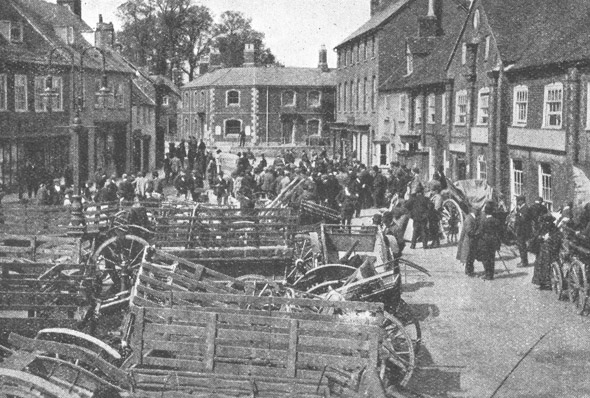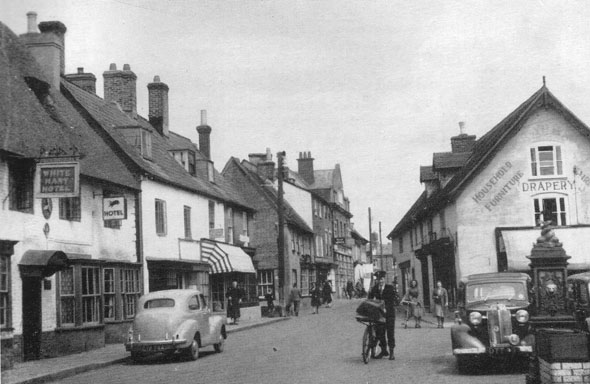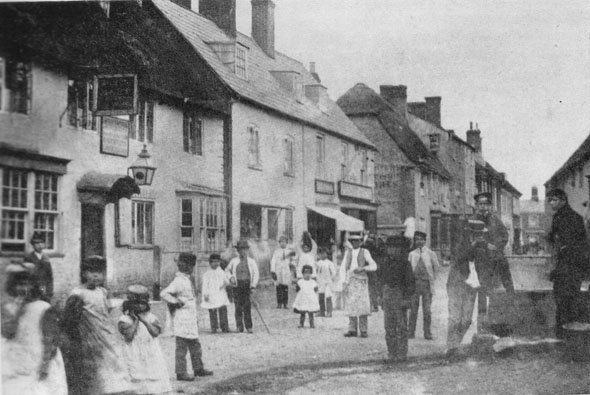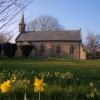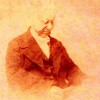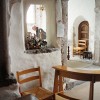A few weeks before his death in 1908 at the age of 97 years, Robert Young, a tailor of Sturminster Newton, decided to write down his memories of life in the town and we are fortunate that his manuscript has survived. Robert tells of trade with Newfoundland, of weavers and button makers, witchcraft and superstitions, education, law and order and, furthermore, mention of William Barnes’ father.
Robert Young was born on the 30th of September 1810 and baptised in St. Mary’s church at Sturminster Newton on the 2nd of November 1810. He was the son of a Marnhull man, James Young, and a Sturminster woman, Mary Collins, who were married in 1799. We know Robert had three brothers and a sister all baptised at Sturminster Newton. Robert married Charlotte Foot at Okeford Fitzpaine on the 28th of May 1834, where the couple lived with their four children at the time of the 1841 census. By 1851 we know from the census the couple were living at Bridge Street, Sturminster Newton and Robert Young was a Master Tailor. We think Charlotte died in 1858 and Robert married again sometime between 1871 and 1881; his second wife was ten years his junior and named Caroline. In 1861 Robert Young was described in the census as a “tailor and woollen draper employing two men.”
Robert’s earliest memory was of a public dinner held in Gough’s Field to celebrate the peace of 1815. It was followed by sports and later marksmen shot at an effigy of Napoleon which was then burned on a bonfire.
Robert went to a school run by Sarah Adams in a cottage next door to the old Methodist chapel. Her husband Abel was a preacher whose activities were not appreciated by all members of the local clergy. On one occasion Abel was summoned by the Vicar of Marnhull for preaching in an unlicensed cottage. Abel attended court wearing his best Sunday coat and told the chairman of the bench that his authority for preaching was the Bible. The Vicar of Sturminster supported him and the case was dismissed. When permission was withheld for Methodist boys to enter the school the same Vicar of Sturminster declared that it was a free school for the children of the poor, Methodist or not. This, we think, would have been a reference to the National school built in 1817. We notice that in 1891 Robert and his wife Caroline had a widower, James Adams, living with them.
According to Robert many of the young men of the town worked for two local merchants, ship owners engaged in the Poole Newfoundland trade. There were wool dyers in the town, probably engaged with the production of broad cloth of which Hutchins comments: “Mr Thomas Colbourne, banker and merchant, financed spinners and weavers who made a cloth known as swan skin used by the Newfoundlanders. The cloth was stretched on racks in the open fields. Buttons, the ring button and the sugar loaf, were also made by numbers of women and children in Sturminster.” A Mr. Mitchel had a soap and tallow candle factory and each year made large Christmas candles for his customers.
Near the old Market House stood two rows of butchers’ stalls and Robert tells us that many of the butchers also attended Poole market, starting off on Wednesday evening and arriving in Poole in the early hours of Thursday. Having sold their meat to the ship captains they set off for home at 10 o’clock at night trusting their horses to carry them safely home, while they slept. Butter was also sent to Poole as well as young calves to be shipped on to Portsmouth. Others were driven for six days on the road to London.
We learn a lot from Robert about wages and the cost of commodities. Labourers toiled from six in the morning ‘till six at night for 6/- (six shillings) a week; a married man got an extra 1/-. Butter was 7/6 for a dozen pounds. Tea was 6/- a pound but roasted and pounded beans were used as a drink. Bread was mixed wheat and barley.
Goods were transported in broad-wheeled wagons drawn by a team of horses often bearing a frame of bells; the carter sat on a smaller horse with a brass-mounted whip. Other goods were moved on pack-horses over roads which were rough and uneven.
Fights were frequent, particularly on market and fair days. Robert recalls one occasion when a “corpulent young farmer fought with a tall wiry butcher. Both had stripped to the waist in Gough’s Close. The young farmer died and the butcher was sentenced to a year’s hard labour for manslaughter.” At that time the Sturminster Magistrates Court was at the back of the Swan Stable yard in a long room over the stabling.
While they awaited trial, the town constables had to take the prisoners to a public house and keep guard over them or take them home with them to their own homes, much to the discomfort of their families. Robert comments “it is not pleasant work to sit with a handcuffed man at night, or to turn your children out of their beds to make room for a burglar…” Robert continues: “I know of a case where a small tradesman had a prisoner in his charge for eight days and nights; an extra man was employed to guard him at night so that the tradesman had a little rest.”
In his manuscript Robert includes a description of a public flogging: “it was a degrading spectacle to witness the poor man stripped to the waist, his hands fashioned to a frame fixed on a wagon, his naked back streaming with blood, whilst amongst the crowd of witnesses were women fainting and screaming.”
Witchcraft was still a potent force in the minds of many people who were known to have sent or even walked to Shepton Mallet (in Somerset) to consult a cunning man in whom they had faith, when they believed they had been “overlooked;” so strong was the belief in some people it would unbalance their minds. Robert comments: “Thanks to more enlightened education, to many valuable lectures, to the railways, to a better knowledge of the world…the nightmare of witchcraft has died out.”
Robert paints a sorry picture of the Sturminster Workhouse near the churchyard, “the business of the parish was conducted in a large kitchen” he tells us. It seems the Overseers were kept very busy providing relieve to the poor.
About St. Mary’s Church we learn that in the early part of the 19th century it had two galleries that were removed during Robert’s lifetime. The violins and bass viol and the bass singers sat in front, behind them the tenors and, in a corner at the back, the two women trebles. An old singer used to give out the psalm to be sung and in a “loud flourish pitch the key of the time.” The boys used to sit each side of the middle aisle on small stools which, when not in use, were hooked up outside the pews. “In winter we found it very cold, especially for the feet, since there was neither matting nor warming flues”.
Among the mixed congregation that sat in the lower gallery of the church was an individual “remarkable for his venerable appearance in his old fashioned brown coat that had done good service for many years”. He was talking about an old labourer who lived in a humble cottage, the father of our Dorset poet – William Barnes.
This first hand memory of fighting, public punishment, long hours of work for little pay, charity and poor relief all formed part of life here as everywhere in the countryside. Particular to Sturminster Newton was its cider mill, where pigs gathered to eat the refuse and the ditch running behind the Rows into which all kind of slops were thrown. When the refuse from the old tan pits was emptied it was sold off in large cakes for a penny to be burnt on the fire.
We can take from Robert Young’s manuscript that at the end of his life he was encouraged by the rising standard of living and the growing humanity. In particular he comments on the greater kindness shown to horses and the benefits of transport of animals by rail. In the place of five or six dens of ruin “we have a savings bank, two highly respectable commercial banks, and two good schools. In place of three deliveries of letters a week, we now have three daily.”
Seemingly out of place, Robert Young’s manuscript sits at the Dorset History Centre in a box containing personal and business papers relating to the Mansel-Pleydell family of Whatcombe House in the parish of Winterborne Whitchurch. John Clavell Mansel-Pleydell Esq. B.A., J.P., and D.L., F.G.S., F.L.S., (1817-1902) of Whatcombe, was President of the Dorset Natural History and Antiquarian Field Club. The manuscript is in a bundle of documents concerning the Revd. James Mitchel, who married Margaretta Morton-Pleydell. Possibly our Master Tailor was a friend of Mitchel or perhaps he was the family tailor.
